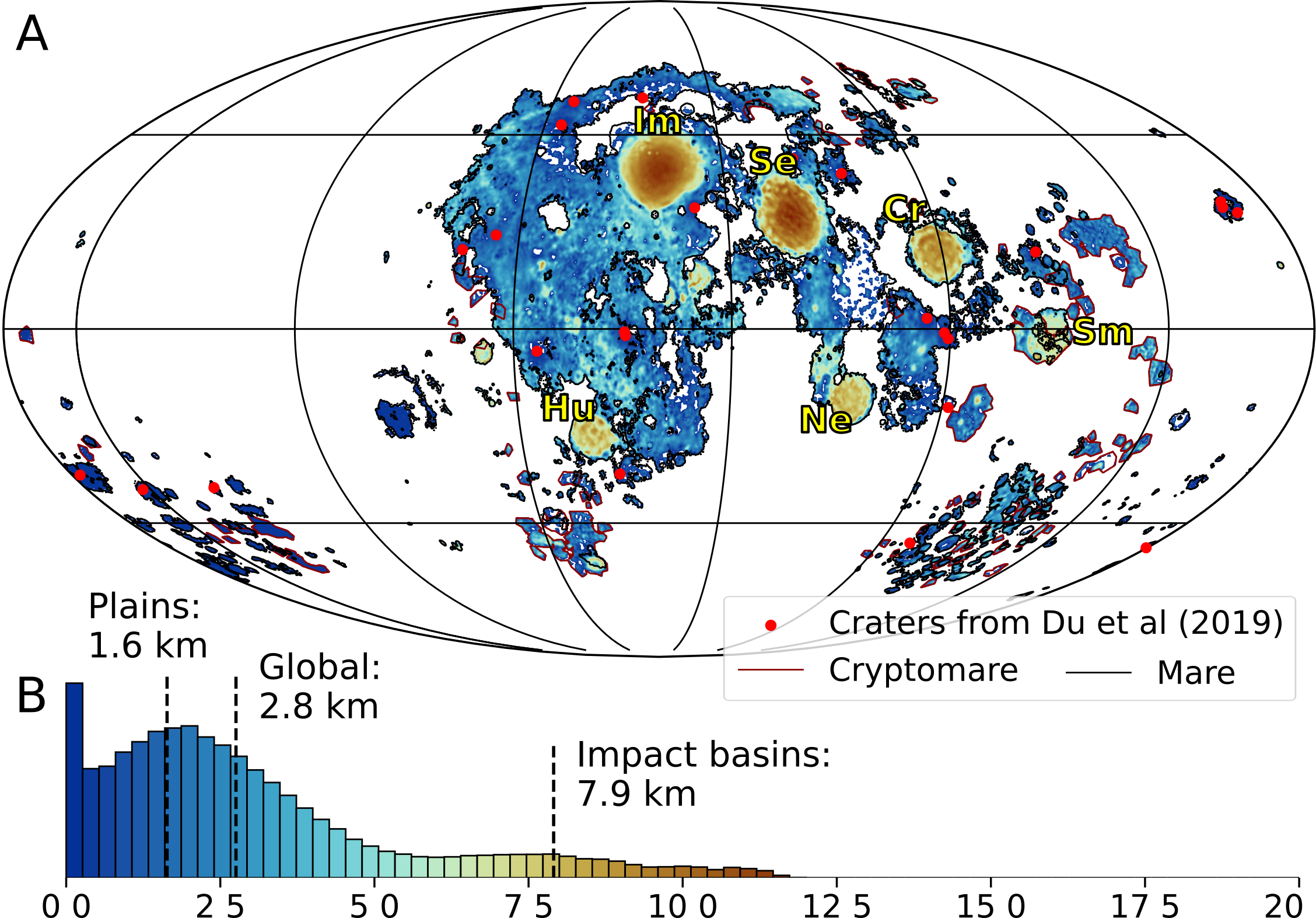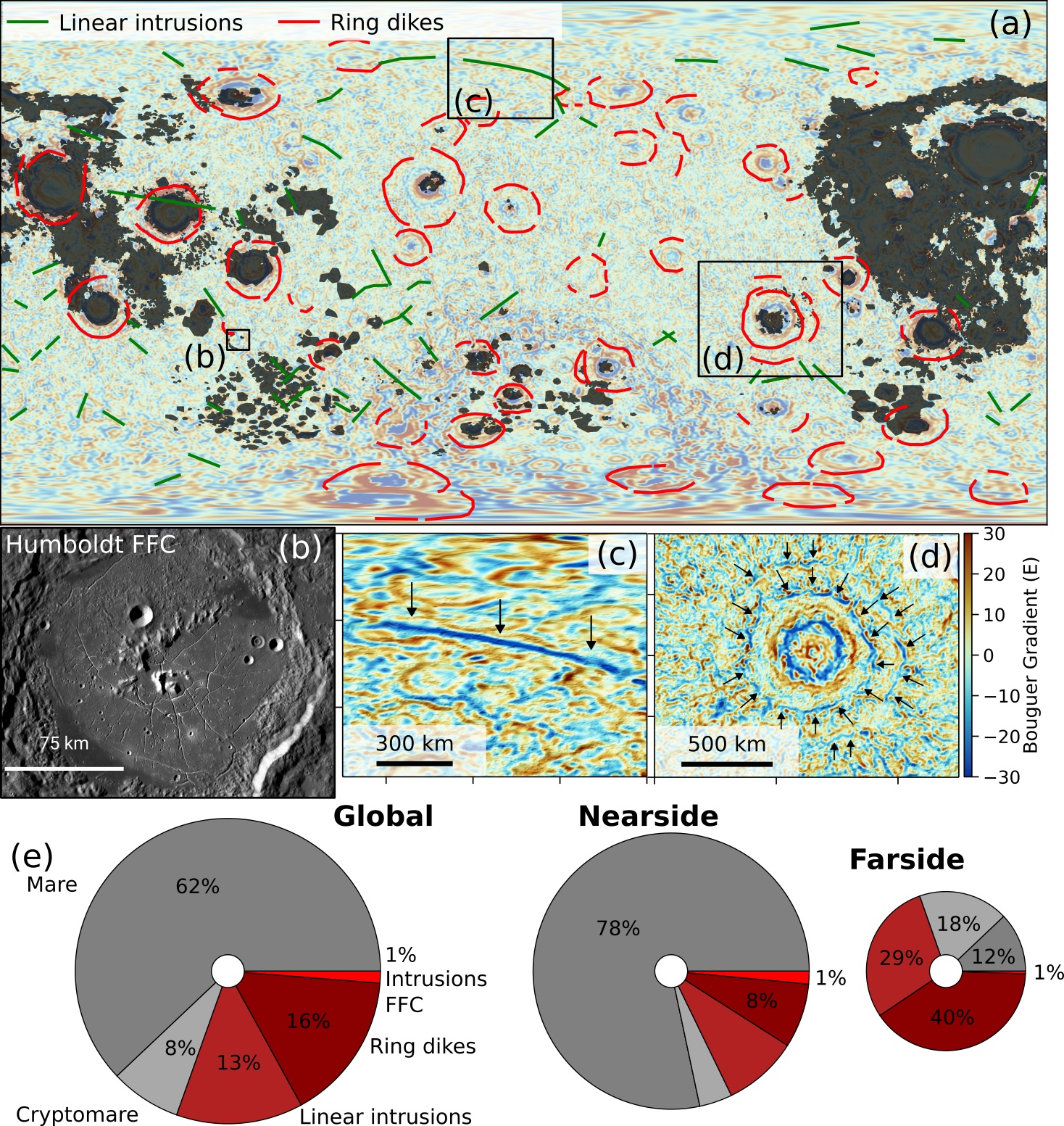Moon
Preamble
The volcanic and magmatic activity of the Moon is intimately tied to its internal thermal and geodynamic evolution through time. While the extrusive nearside maria dominate the volcanic record, little is known regarding their underlying structure and the details of their emplacement. Intrusive activity is even more enigmatic, with most intrusions expressing little to no surface signature. Although some prior studies have provided insights into the local igneous activity, no global compilation has been conducted.
The Moon before mare
In Broquet & Andrews-Hanna (2024a), we invert gravity and topography data using a two-layer loading model under the premise of pre-mare isostasy to investigate the global structure of the crust. We solve for feldspathic crust and mare thickness, together with mare-induced flexure. We show that mare are thick within large basins, ~8 km, but drastically thinner outside, ~1.5 km (Figure 1). Our mare thicknesses are used to construct maps of the Moon before mare. In these maps, the pre-mare surface in the Oceanus Procellarum region is found to be ∼2 km lower than the surrounding nearside, and several possible explanations, including a giant impact, pore space annealing, isostatic adjustment, and crustal erosion induced by a mantle plume or thermal anomaly, are discussed. The feldspathic, pre-mare, crust is found to be ∼7 km thinner within large nearside basins than in models not accounting for the high-density mare. The pre-fill floor of these basins was ∼6 km deeper than currently observed, and together with their updated crustal structure, these new insights have implications for impact simulations that try to reproduce the crustal structure of nearside mare basins.

A volcanic inventory of the Moon
In Broquet & Andrews-Hanna (2024b), we present a volumetric inventory of extrusive and intrusive activity (Figure 2). Our preferred volumes of mare and cryptomare are 18.2×106 km3 and 2.2×106 km3, respectively. Crustal intrusions associated with linear gravity anomalies, floor-fractured craters (FFC), ring dikes, graben, and beneath volcanic constructs, are investigated and yield a total volume of 9.1×106 km3. Our inventory reveals that intrusive activity dominates in the farside (intrusive:extrusive ratio of 5:2), whereas extrusive volcanism is more pronounced in the nearside (1:5, Figure 2). The combined volume of intrusives and extrusives is found to be 3 times greater in the nearside than in the farside. Both are related to the lunar asymmetry in which the thinner crust and warmer subsurface beneath the Procellarum KREEP terrane enables enhanced melting and magma ascent. These observations have implications for the interpretation of the thermal and geodynamic history of other celestial bodies, where intrusive volcanism remains poorly constrained.

Vestiges of lunar global mantle overturn
The lunar crust and mantle formed through the crystallization of a magma ocean, culminating in a solid cumulate mantle with a layer of dense ilmenite-bearing cumulates rich in incompatible elements forming above less dense cumulates. This gravitationally unstable configuration probably resulted in a global mantle overturn, with ilmenite-bearing cumulates sinking into the interior. However, despite abundant geochemical evidence, there has been a lack of physical evidence on the nature of the overturn. In Liang & Broquet, et al. (2024), we combine gravity inversions together with geodynamic models to shed light on this critical stage of lunar evolution. We show that the observed polygonal pattern of linear gravity anomalies that surround the nearside mare region is consistent with the signature of the ilmenite-bearing cumulates that remained after the global mantle overturn at the locations of past sheet-like downwellings (Figure 3). This interpretation is supported by the compelling similarity between the observed pattern, magnitude and dimensions of the gravity anomalies and those predicted by geodynamic models of the ilmenite-bearing cumulate remnants. These features provide physical evidence for the nature of the global mantle overturn, constrain the overturn to have occurred before the Serenitatis and Humorum basin-forming impacts and support a deep Ti-rich mantle source for the high-Ti basalts.
